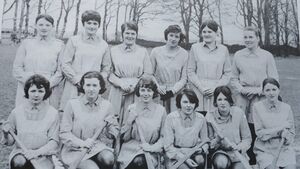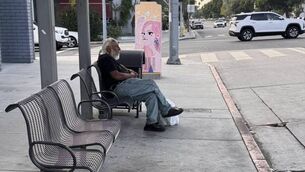Skorts controversy is a relic of McQuaid's Ireland

The Breaffy Camogie team before their All-Ireland club championship clash with Bellaghy of Derry in Breaffy in March 1971. Their uniforms are a reminder of a different Ireland, one the Camogie Association appears slow to move from with the recent skorts controversy. Back row, from left: Maura Walsh, Mary Clarke, Bennie Heneghan, Mary Barrett, Ann Clarke and Patricia Golden. Front row: Rosaleen Jordan, Ann Kilcourse, Ann Burke, Geraldine Jordan, Elizabeth Clarke, Helen Golden.
Before I was even born in Breaffy, there was a very successful camogie club in the village.
In the late 1960s and early 1970s, Breaffy were the queens of camogie in Mayo. They won their first Mayo Senior Camogie Championship in 1968 and claimed a four-in-a-row from 1970 to 1973.
They also won a Connacht senior title in 1970, going on to host Bellaghy of Derry at home in Breaffy in an All-Ireland senior semi-final in March 1971. Alas, the Derry side were too strong and Breaffy’s shot at All-Ireland glory ended there.
The game was hugely popular in the area at the time with rivals around them including teams in Keelogues, Castlebar, Turlough, Ballintubber, Islandeady and as far away as Achill.
Mayo had successful teams at the time too and the county contested an All-Ireland senior final in 1959, losing to Dublin, and won Connacht titles in 1967 and 1973.
Considering how women’s sports in general were on a low keel until relatively recently and considering how Mayo would not be regarded as a hurling or camogie county, it was a remarkable period for the game.
My aunts Ann (RIP) and Frankie McGreal were among those who featured on those teams, backboned by big local GAA families like the Jordans, Clarkes, Goldens and Heneghans.
The camogie club in Breaffy was formed in 1966, but with the game in decline in the county from 1973 onwards, the Breaffy club faded too. As you look at photographs of them in their heyday in light of the current controversy over skorts in camogie, you can’t help but wonder how we are still having these discussions.
The Breaffy uniform looked anything but comfortable for the playing of a field sport. Long-sleeved, stiff-collar shirts sat inside a pinafore dress with tights underneath.
It spoke to the Ireland of the time. In the 1930s, Camogie Association Secretary Seán O’Duffy, a native of Killawalla, vowed the association "would do all in its power to ensure that no girl would appear on any sports ground in a costume to which any exception could be taken".
It was a time when the all-too-powerful Archbishop of Dublin John Charles McQuaid had decreed that women who sought to compete athletically in the vicinity of men were "un-Irish and un-Catholic".
That culture still had a considerable hold into the 1960s and 1970s. There certainly could be no exception taken to the outfits the Breaffy women wore. Perhaps playing at all was an achievement given the patriarchal society that held sway.
That is over 50 years ago and it is hard to credit, in spite of all of the massive strides women’s sports in this country have made, particularly in the past two decades, that appearance and harking back to a patriarchal tradition is still an issue in the Camogie Association.
Under the Camogie Association’s rules, players must wear a ‘skirt/skort/divided skirt’. A ‘skort’ is a combination of shorts and a skirt.
This is despite the fact that 70% of players, according to the Gaelic Players’ Association, would prefer to wear shorts, finding skorts uncomfortable and restrictive. Leading players have been highlighting this issue for years.
Despite this overwhelming opposition to skorts, the good people at the 2024 Camogie Congress rejected both replacing skorts with shorts (64% said no to that) or giving players the choice to choose between skorts or shorts (55% gave that the thumbs down).
It really shows how out of touch delegates at such conventions can be and would tally with this writer’s experience of GAA Congress. It must be pointed out that the Camogie Association is an entirely separate organisation to the GAA. Plans are slowly advancing for the merging of the GAA, the Camogie Association and the Ladies Gaelic Football Association but this debacle reveals the stubbornness that exists in the Camogie Association in spite of a clear opposition from the most important element of all, the players themselves.
Having the players front and centre of their sport is a notion that far too many GAA, Camogie and Ladies Football administrators have found hard to swallow over the years.
It remains to be seen if a merger will see a more enlightened approach. Thankfully, it appears the end is nigh for the compulsory wearing of skorts.
Dublin and Kilkenny camogie players initiated the current revolt ten days ago when they emerged on the pitch at Blanchardstown for their Leinster semi-final wearing shorts. They were ordered by the referee, in line with the rules, to return to the changing rooms and put on skorts.
That brought the issue to the national consciousness. Subsequently, Dublin Camogie instructed its referees to allow games to go ahead even if players refuse to wear skorts.
Throughout last week, the Cork and Waterford camogie players cranked up the pressure on the Camogie Association by stating they would be wearing shorts for last weekend’s Munster final.
All of this forced the Camogie Association's hand. They cannot change the rules themselves, they require a congress or special congress to do so. Their next congress is not until 2027 so they have called a special congress for May 22 at Croke Park.
“Although similar motions did not pass at the 2024 Congress, the Association is committed to representing the voices of players who wish to have a choice in their playing attire,” said the Camogie Association in a statement.
It is spelling out in no uncertain terms to its delegates that the players need to be listened to. The delegates, it seems, are being dragged kicking and screaming into the 21st century. This is an issue which ought to have been dealt with long ago.
It would be much more in the Camogie Association’s interest if they could focus their energies on growing the game throughout the country. Hurling has grown considerably in Mayo in recent decades with a footprint in most parts of the county now but camogie has not grown to the same extent.
It was great to see Mayo reform at inter-county camogie in 2021. They won an All-Ireland Junior title and Division 4 league title that year. However, it was sad to hear the news earlier this year that Mayo were disbanding their senior camogie team in the wake of some heavy defeats last year.
While there are still Minor and Under 16 camogie teams representing the green and red, the lack of an adult team is indicative of how much work the Camogie Association needs to do. Mayo had teams in the 1950s, '60s and '70s when there was a far less enlightened attitude to women in sport. Their success appears all the more remarkable now.






